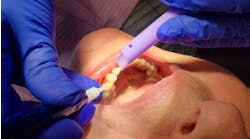While most dentists really enjoy the clinical side of their practice, many find the business side frustrating. I have long felt that dentists underestimate their ability to run their business effectively. We find the happiest and more successful dentists have learned to enjoy both the clinical and business parts of their practice.
Managing your business is much easier with good systems in place to monitor key areas. You can accomplish this by developing a daily flash report. Here are my recommendations for the 10 daily practice statistics:
Over-the-counter collection percentage
Over-the-counter collection percentage represents a good way to track how well your front desk collects the co-pays. Over-the-counter collections refer to the portion of your fee that you collect from today’s patient today. This should be about 35% of the day’s production.
RELATED | The secret rules of sharing numbers with your dental team members
Number of cancellations or no-shows
Many times we will hear from a dentist that they have a high no-show or cancellation rate. Often, upon investigation, we will find no real statistics but rather a feeling by doctor or staff. It is essential to track these numbers rather than guess.
RELATED |What happens at the end of the day in the life of your business coordinator?
Number of new patients seen
Statistics tell us that the average practice may lose as much as 10% of its patient base through normal attrition. We recommend that the practice set a goal of 15% growth in order to achieve actual growth. If your practice accepts any discount type of plans you should track the breakdown of those plans vs. fee-for-service.
Ratio of treatment presented vs. treatment accepted
Perhaps one of the most important numbers you can track in your practice is the ratio between treatment presented and treatment accepted. By getting solid information on the amount of treatment accepted, we can identify whether doctor or staff needs to improve their treatment presentation skills. A good benchmark is an acceptance ratio of 70% to 90%.
Doctor and hygiene production per hour
One of the key numbers a doctor should track is his or her own production per hour. If your practice accepts discounted fee programs, it is a good idea to calculate both the gross production per hour and the net production per hour. The clients I work with average about $375 per hour with about 20% achieving over $500 per hour. In a typical practice, an increase of $50 per hour for the doctor represents about a $73,000 increase and additional profit of about $60,000! Similarly, the doctor should monitor the hygiene production per hour. The average per hour we see is about $100.
Number of patients seen each day
The number of patients seen each day by both doctor and hygienist should be monitored. The ideal for the doctor is eight to 12 patients. It is also a good idea to monitor patients who left without scheduling their next appointment.
Ratio of unscheduled units for doctor and hygiene to total available
By tracking this statistic, we can determine how efficiently we are scheduled. In today’s economy, many practices have surplus capacity resulting in an overstaffed practice.
Production adjustments
The dentist should always have a handle on the amount and type of production adjustments made in the practice. You want to pay particular attention to the write-downs. Make it a habit to ask frequent questions of your front desk staff regarding adjustments.
Number of new-patient phone inquiries compared to appointments set
One activity measure that tells a lot about the effectiveness of your advertising and marketing is tracking the number of new-patient phone inquiries compared to number appointed. We frequently see front desk staff using ineffective techniques, limiting the number of new patients appointed.
Funds deposited in the bank compared to day sheet
Tracking deposits is a good deterrent to embezzlement. Your staff should print off the day sheet for you to take home. This lets them know you are engaged in the finances of your practices.
These statistics, collected by your staff and reviewed by you in a matter of a few minutes, will put you in the habit of keeping a close eye on some very important key numbers.







